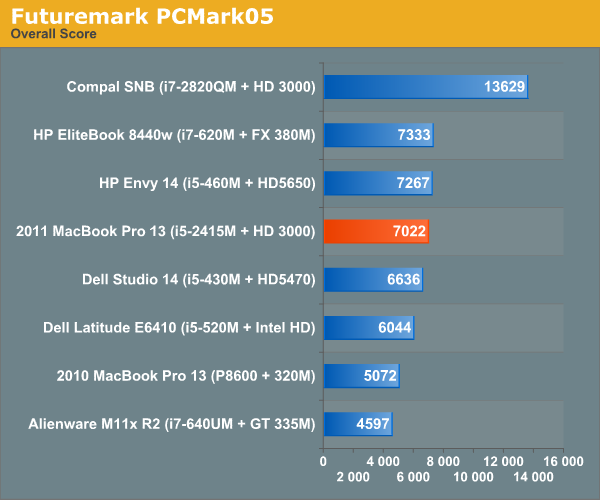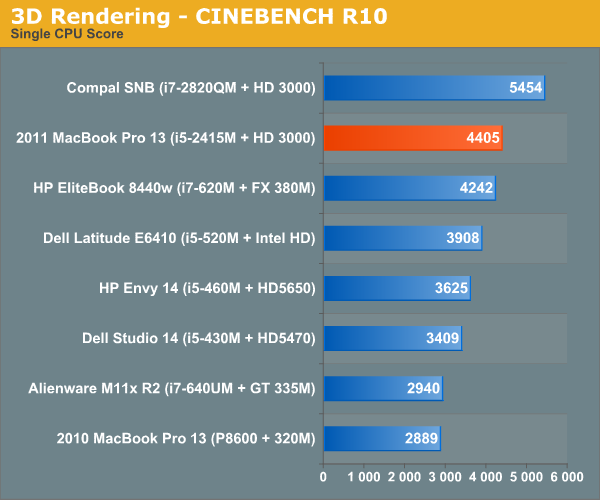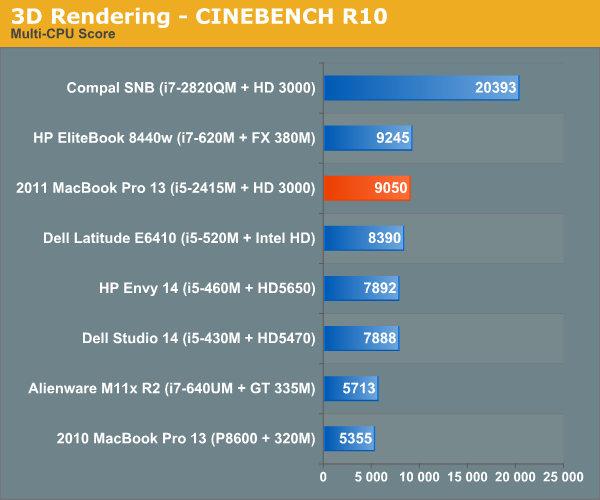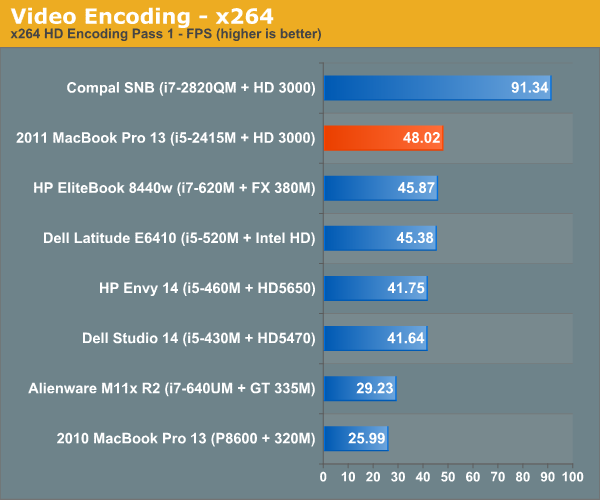The MacBook Pro Review (13 & 15-inch): 2011 Brings Sandy Bridge
by Anand Lal Shimpi, Brian Klug & Vivek Gowri on March 10, 2011 4:17 PM EST- Posted in
- Laptops
- Mac
- Apple
- Intel
- MacBook Pro
- Sandy Bridge
Application Performance in Windows
by Vivek Gowri
In keeping with recent tradition, I'm in charge of evaluating the new MBP under our Windows notebook benchmark suite. Mostly, the MBP works very well as a PC, something I looked at last year with the old 13-inch MacBook Pro. I have the new base 13 in the labs, and I must say, the overall experience is pretty similar...unless you're gaming. But I'll get to that in a minute.
Unlike on the Air I was testing last time around, the Windows install went pretty smoothly thanks to the built-in optical drive. Unfortunately, that's probably going to be the last time I ever use it. And also unlike the Air, there's no problems with storage space here—with the 320GB drive included in the base 13, you have more than enough space for two moderately-sized OS install partitions.
With Windows and Boot Camp drivers out of the way, I fired up our notebook benchmark suite. The new MBP is the first dual core Sandy Bridge notebook we've had in our labs, so I was pretty interested in seeing the performance relative to Arrandale, as well as the old Core 2 Duo-based MBP13. According to CPU-Z, the base spec 13 that I have has the i5-2415M inside, a dual core processor with HyperThreading and clocked at 2.3GHz with max turbo frequency of 2.9GHz. The 2415M is an interesting chip, closely related to the i5-2410M. It's so interesting that Intel doesn't even have a product page for it, which made me curious as to what the difference between the two is. Turns out, the 2415M is the same chip as the 2410M, just in a smaller package. The normal mobile Core i5/i7 processors have a 37.5 x 37.5mm PPGA (plastic pin grid array) package, meant for Socket G2 (also known as rPGA 988B).
The 2415M, on the other hand, has a package size of 31 x 24mm with a micro-FCBGA mounting method. It's the same package size and mounting as the low voltage and ultra-low voltage Sandy Bridge processors, using the same BGA 1023 socket. Apple probably chose the 2415M to make packaging around the processor easier. Smaller is always better in the Apple world.
The other interesting wrinkle here is that Apple has forgone a separate graphics chip for the first time in a very long while. This is the first Apple with Intel graphics since the MacBook's January 2009 refresh brought Nvidia 9400M graphics, and the first MacBook Pro with Intel graphics. Ever.
What does all of this mean for performance? Let's take a look. If you're comparing to the old Core 2 Duo based MBP13, CPU-based performance is almost two times faster across the board. Given the huge jump in power between Core 2 and the further two generations of Core processors, this makes a lot of sense. It was seriously about time that Apple moved on from Core 2 in its smaller notebooks, and this huge performance jump is a direct result. We'll see what happens with the regular MacBook and MacBook Air, but I'd expect a similarly large increase in performance in those models when they're next updated as well.






Looking at the Arrandale-based Core i5-430M, which at 2.26GHz is a logical point of comparison to the i5-2415, we see that performance has improved 15-20%.
This doesn't look as impressive as the gains in performance we saw with our first look at the mobile SNB quad-cores, but Sandy Bridge quads are clocked a lot higher than the preceding Clarksfield chips. Our quad-core SNB mobile testbed had an i7-2820QM, with a 2.3GHz core clock and max turbo frequency of 3.4GHz. The 2820QM replaces the 1.86GHz i7-840QM, so the clock speed is 24% higher. Factor that in, and the increase is more in line with what we saw from the dual-cores.
The big deal here is that now, the lowest end SNB i5 performs roughly on par with the top end Arrandale i7 dual cores. Like Anand said in his Sandy Bridge review, you get yesterday's top of the line performance for a much lower price.










198 Comments
View All Comments
Brian Klug - Friday, March 11, 2011 - link
So I roll with my optical drive replaced with a Vertex 2 SSD inside an OptiBay daily. It's an awesome combination if you can do it.One problem I noticed however is that Apple's EFI won't boot optical drives other than their own $79 external drive. That means if you want to use boot camp, you have to install Windows with the optical drive (internal SATA) connected, then do the swap to OptiBay SSD + HDD.
-Brian
AmdInside - Thursday, March 10, 2011 - link
I'm just not that interested in this years lineup. The better CPU performance is nice but given how much more features Windows notebooks provide today, I feel I can rely on Windows notebooks as a desktop replacement much more than I can a Macbook Pro. I will still use my MBP 13 2010 for home use but for business, I rely on my Windows laptop.Braddik - Thursday, March 10, 2011 - link
Amazing article! I love how thorough and detailed you are. Mad props! I work in a medium-large size organization and the Dell vs. Apple debate is hot right now. Our Mac user base is growing, but the majority of the organization is Dell. I would love an article that compares the performance/value/support of MacBook Pros vs. Dell Latitudes in the Enterprise environment. Which is better? Can/should organizations feasible make the move to a full Mac environment? I would love your input! Thanks!Anand Lal Shimpi - Friday, March 11, 2011 - link
Thanks for the kind words. I'm not sure I can offer much advice in terms of how the MBPs fare in an enterprise environment. While I know of many corporations that now issue OS X systems as an option, those systems typically have some form of Windows on them (either via Boot Camp or as a VM).Perhaps someone else may be able to offer more input?
Take care,
Anand
Chloiber - Thursday, March 10, 2011 - link
I still think it's too early to completely throw away desktops.With my T410, I also made the change to use it as my main "working" computer. At home, I can dock it and use my big, comfortable screen. It's very fast in "normal" usage like simple programming, texting, surfing, some "medium" load graphical stuff, some MATLAB etc. etc. - it's just perfect.
But as soon as I want to do really heavy stuff like hours of video encoding, I still switch to my desktop with 4 or more cores and a fast dedicated GPU. It's just not the same and I really don't like to stress my laptop that much (allthough it is a Thinkpad). I don't know - I'm even less comfortable with a quad in my notebook. I don't know, but it's just not the same as a Desktop for really heavy stuff.
I do like the new MacBooks - I don't like the resolution of the 13" model though...it's awful...
Ushio01 - Thursday, March 10, 2011 - link
While i expect a Mac Pro refresh late 2011 early 2012 I wonder if it could be the last. With the discontinuation of xserve and as this review demonstrates a mobile CPU matching less than year old server level parts in performance and thunderbolt allowing highspeed access to a NAS box I can see Apple discontinuing there last product targeting solely the professional market and truly becoming a CE company.rural_oregon - Friday, March 11, 2011 - link
Yes, I have to agree with you. With macs only 20% of Apple's total revenue, and the mac pro only perhaps 5% of the mac revenue, at some point soon it just won't be worth the effort. I think it's even possible that there may not even be a sandy bridge mac pro.tipoo - Friday, March 11, 2011 - link
It certainly seems like a possibility. Apples focus really has shifted to mobile devices, and its Mac revenues are only about a fifth of what the company makes. I can't imagine the Pro is any substantial percentage of their revenue, 1-5% perhaps. Might not be worth the effort for them. On the other hand, it would irk mac developers and creative pro's.wast3gat3 - Thursday, March 10, 2011 - link
Just a short thanks for such an in-depth review.I have a mid-2010 15" MBP and am upgrading this week to the 2011 15" MBP as the performance gain is just too good to pass up. Interesting though that Apple locks the TRIM support in to their own SSD. I'm still going with the 7200rpm 500GB option and will move that disk to an opti-bay and the 3GB controller now knowing that they are using B3 stepping and fit a 6gb sata SSD. Hopefully LION will fix that TRIM support or some clever cookie works out how to enable it.
Once again thanks!
Kuril - Thursday, March 10, 2011 - link
I always wait for AnandTech reviews because they are almost aways the most comprehensive. I love how the technology behind the reviewed product is summarized, and that there is some footwork to better describe the exact hardware being used (e.g., CPUs for MacBook Pros).Thanks for the informative reviews. No one comes close.